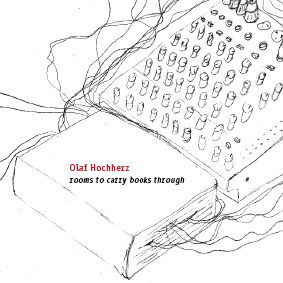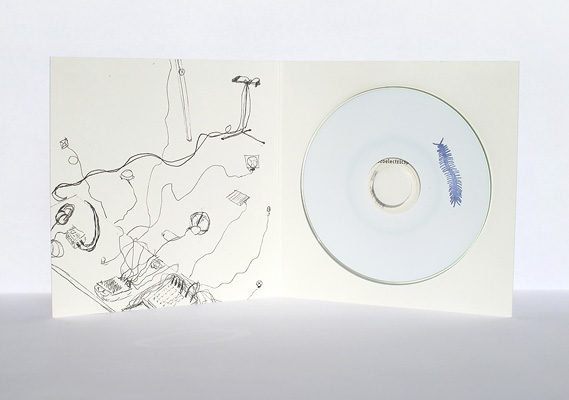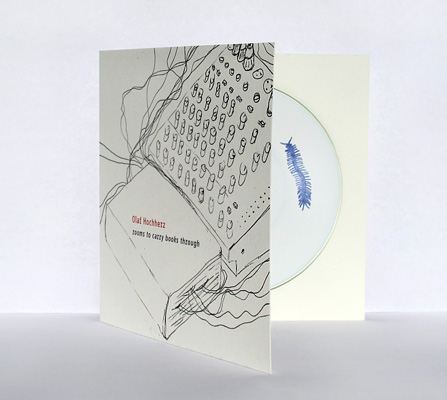

OLAF HOCHHERZ
Rooms To Carry Books Through
3“CDR, (21'00'' ), 50 copies, cardboard sleeve
1000füssler 018, recorded and mixed Berlin 2012. released in march 2013
The setup I use consists of two parts an electronic instrument and ten speakers. The speakers are switchable they are used to distribute the sounds in the room. The instrument is a combination of piezoelectric contact microphones and piezoelectric speakers placed inside a book. The book is a resonator and a filter. The instrument is based on the feedback between piezo microphones and speakers. In order to play the instrument I press my hands on top of the book, thereby the conditions for the feedback change.
I didn‘t try to make an electronic device, which is controllable in the same way as a classical acoustic instrument, instead I work with the abstraction of the electronics. In my playing i do not control a technical apparatus, but create an associative field. The sounds have their own live. The playing tries to keep them alive. (Olaf Hochherz)
1. Rooms To Carry Books Through 21'00'', mp3 excerpt 1 / mp3 excerpt 2

About the Artist:
Olaf Hochherz lives and works in Berlin and Shanghai. He is performing with self build electronic instruments and computer programs. He is interested in the conjunction of the instability and associative capacity of sounds. He is born 1981 in Wuppertal/Germany. He studied at Folkwang Hochschule Essen electronic composition and at Bauhaus University Weimar media-art/media-design.
http://hochherz.klingt.org

REVIEWS:
Neural Magazine / Italy
Olaf Hochherz is a specialist. His CDR and mini-albums, released between 2007 and 2013, were released on very underground labels such as Desetxea, Naivsuper and Kwanyin. Now on 1000füssler, he presents us with a 50 copy limited edition CDR 3″ release, recorded and mixed entirely in Berlin with a very experimental set-up. Ten switchable loudspeakers distributed sound in a room, while sound iterations were created using contact microphones and piezoelectric loudspeakers placed inside a book. The book acted as a filter and a resonating device, without any frills or unnecessary controls, modulating the feedback of the elements. Pushing on the upper part of the book, the artist was able to create changes in the flux of the sound. If we understand correctly Hochherz was aiming to create an electronic system with a very abstract physicality. Control over sound was not dependant only technical equipment, but focussed on associative fields generated in realtime. Due to the instability – physical and theoretical – of the connections and to the associative capacity of the sounds, the flow features some blanks. However, the record remains attractive and moody, characterized by a granular and abrasive lo-fi spirit. Rooms To Carry Books Through emphasizes the relationship between the devices and the surrounding environment, giving life to abstract sounds and odd electric mixes: the result is unstable and minimal, but also very intimate, lively and filled with potential relationships.
Aurelio Cianciotta / 13th January 2014, Neural Magazine 46, (you can read also in: italian)
Vital Weekly / Netherlands
Germany's 1000Füssler label launches a new series of 3"CDRs, in a small edition (50-65 copies) and the first three all seem to have some sort of conceptual edge to them. (...) Perhaps the release by Olaf Hochherz is least conceptual, but it involves an instrument of his own making - "a combination of piezoelectric contact microphones ad piezoelectric speakers placed inside a book. The book is a resonator and a filter. The instrument is based on the feedback between the piezo microphones and speakers". He plays it with his hands and the sound is distributed over ten speakers. His pieces lasts twenty-one minutes and like with Asnan that is dictated by the length of a 3"CDR, as this could have as easily lasted two hours too. Not something I wanted, as, again like Asnan, these twenty-one minutes give me enough impression of what it sounds like. But to be honest, without the description I would think this had all something to with maybe a bunch of crackle boxes being played. Chaotic, disorganized and a bit noisy, this is circuit bending at it's best. With or without a concept.
Frans de Ward / Vital Weekly 879
Improve Sphere / France
utilisation instrumentale d'objets non-musicaux: (..) Dans une veine similaire, Olaf Hochherz tente lui aussi de créer de la musique à partir d’une source sonore extérieure au domaine musical. Rooms to carry books through est une pièce de vingt minutes fondée sur une source sonore plus qu’incongrue, un livre, objet silencieux par excellence... C’est aguichant, étonnant et surprenant dans l’idée peut-être, mais à vrai dire, je ne suis pas sûr qu’une absence de sources sonores aurait changé grand-chose à cette pièce. Le livre est relié à tout un système de dix enceintes et de microphones piézoélectriques qui génèrent un larsen modifié par la pression exercé sur le livre. Il s’agit donc bien plus ici d’une exploration des champs piézoélectriques que des propriétés sonores d’un livre. En résulte une pièce très électrique et abrasive, improvisation granuleuse aux sonorités primitives et lo-fi. Ça grince, ça couine, ça pète, musique défectueuse et parasitaire, improvisation basée sur le bricolage et le bruit. Pas exceptionnel, mais j’aime plutôt bien ce côté simple et archaïque, ainsi que l’énergie avec laquelle l’instrument est utilisé.
Julien Héraud, 20 avril 2013, improv-sphere.blogspot.fr
Bad Alchemy / Germany
OLAF HOCHHERZ entlockt auf "rooms to carry books through" (1000füssler 018, 3" CD-R) tatsächlich Büchern Töne. Indem er sie piezoelektromikrophoniert und durch Druck das Feed-back zwischen Mikrophönchen und Lautsprecherchen verän-dert. So bringt der Folkwang- und Bauhaus-geschulte Wup-pertaler, der seine Lebenszusammenhänge auf Berlin und Shanghai verteilt, selbst ernsthafte Lektüren loonytunesk zum Sirren, Fieben, Rauschen, Schnarren, Schaben oder Wispern. Er inszeniert knatternde und zwitschernde Alienatta-cken, mit bug-eyed Monstern in Buchstabengröße. Oder macht Odradeks zumindest hörbar, wenn auch nicht erklärlich. Und auch das nur zufällig, denn zu beherrschen sind die 'Hör-buch'-Versionen von Science Fiction, von teilchenphysika-lischer Fachliteratur oder von mikrobiologischen Geister-geschichten nicht. Mit Fingerspitzengefühl kann Hochherz aber ihr Eigenleben verändern und verlängern.
Rigo Dittmann / Bad Alchemy 77
Le Son du Grisli / France
Muni de micros piezo, baffles, mixer…, Olaf Hochherz s’attelait en 2012 à Berlin à l’électroencéphalogramme d’un livre. Les résultats de l’expérience sont à entendre sur Rooms to Carry Books Through – qui évoquent à leur façon le Voyage autour de ma chambre de Maistre: soufflements, silences, respirations infimes et réactions minuscules d’un livre qu’Hochherz peut aussi provoquer du doigt. Bientôt, c’est un prélude qui convainc l’amateur de papier qu’une faune jusqu’alors inconnue s’affaire entre ses pages.
Guillaume Belhomme, 3. juli 2013 grisli.canalblog.com
www.1000fuessler